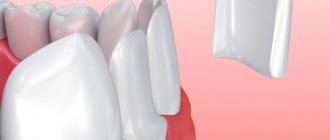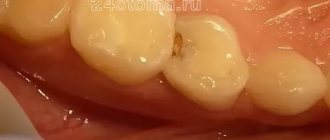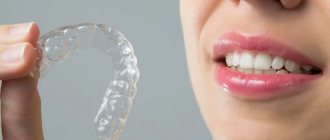If the resulting hole in the tooth is not filled in time, it may collapse and will have to be removed over time. You need to figure out why holes appear in teeth and how to deal with them.
The most basic reason for the appearance of a hole is tooth disease with caries, which first appears as a small dark spot on the tooth enamel. If caries is not treated at the initial stage of its appearance, it can gradually grow, penetrate into the tooth pulp and form a carious cavity. This cavity must be filled so as not to lose the entire tooth. A filling is placed if the tooth is affected by simple caries or complicated caries, or if pulpitis or pericementitis occurs.
Installing a seal
The task of the doctor who has discovered a tooth damaged by caries is:
- drilling out dead tooth tissue and darkened parts of enamel;
- expansion of the carious cavity;
- checking the condition of the pulp;
- preparing the tooth for filling.
The filling process consists of:
- in disinfecting the drilled cavity and drying it;
- installing a medicinal inlay into the tooth canals;
- installation of a temporary filling;
- A permanent filling is installed when a tooth is cured and the lost parts need to be restored.
Tooth preparation
This procedure includes the following manipulations:
- Treatment of affected tissues . All pigmented areas on enamel and dentin are carefully removed. In case of incomplete elimination, pigmented areas will appear against the background of the filling, and an attempt to cover them with a cement composition will not be successful.
- Formation of the enamel edge . When preparing cavities of classes 3-5, bevels are made on the enamel (their angle is 45°), which creates an imperceptible and smooth transition of the filling into the enamel. When the cavity belongs to classes 1 and 2, a fold is not made, since the cement wears out and wears out faster than the enamel layer.
- Removing deposits. Unremoved plaque prevents contact of the material with the hard tissues of the organ.
To improve adhesion, mechanical cleaning of formations from the enamel is carried out with a special brush, oil-free pastes (gels) or a device that removes deposits using a mixture of soda and water under pressure. - Opening the enamel prism .
Manipulation involves removing a thin structureless enamel layer covering the prismatic fascicles. Such manipulation and further etching improve the adhesion of cement, especially when it is applied to erosive and hypoplastic areas of the enamel, or to a large area of fracture of the coronal part. - Isolation from moisture and subsequent drying .
This must be done carefully, as moisture reduces adhesion. The most effective device for isolating saliva, according to dentists, is a dental dam. If this is not available, the doctor may use cotton swabs. When it is necessary to eliminate the possibility of liquid penetrating into the gingival cavity, special threads are used that are impregnated with a hemostatic compound. - Applying a gasket (as indicated). It is covered with ionomer cement paste on top.
- Forming the foundation. Manipulation is carried out if there is a deep cavity, or pins will be installed. For these indications, a base is created from the composite and ionomer mass, which is then covered with a composite of the desired shade.
- Etching the enamel . The duration of the procedure should not exceed 20 seconds. Afterwards, the used acid (gel) must be carefully removed and the etching area dried with air.
- Primer application (if indicated only). It is introduced if the cavity reaches the dentin. The primer is applied with a special brush, and then (after about 20-30 seconds) non-volatile compounds of the drug are blown out with air.
- Adding adhesive mass. The adhesive composition is introduced into the cavity with a brush, and then distributed over the walls with air.
If it is two-component (i.e. chemically cured), no lamp treatment is performed. When the adhesive is one-component, i.e. light-curing, it is heated with a lamp for 10 seconds.
Types of permanent fillings
- Metal seal. Advantages: long service life, inexpensive cost. Disadvantages: long hardening time, contrasting color with the color of the enamel.
- The cement filling can be phosphate or glass ionomer. Advantages: release of fluoride ions, which prevent the formation of caries. Disadvantages: fragility and short service life.
- Composite fillings are made from an epoxy mixture. Advantages: long service life. Disadvantages: long time to install the filling.
- Plastic fillings are made on the basis of acrylic acid. Advantages: high strength. Disadvantages: the formation of micropores in the filling, through which caries can penetrate.
- Ceramic inlays are used to restore a damaged tooth. Advantages: strength and reliability. Disadvantages: high cost and long installation time.
What are glass ionomers
This is a type of silicate materials or cements (a mixture of aluminosilicate glass, fluorides and polycarbonate acid) in paste or powder form, which in modern dentistry are gradually replacing classical cements based on zinc phosphates, and are increasingly used in dental fillings. Glass ionomers are also abbreviated as GIC.
What accounts for the success of glass ionomers?
- high degree of adhesion: this means the strength of adhesion of the glass ionomer to dentin,
- high degree of biocompatibility with the human body: GIC is identical in its thermal characteristics to tooth tissue, which almost completely eliminates its premature depressurization,
- lack of toxicity: the material is hypoallergenic, safe, does not cause intoxication of the body, which provides ample opportunities for its use in sealing root canals and mammary units,
- antibacterial effect: due to the fact that the material contains fluorides, the risk of developing an inflammatory process and repeated caries under a glass ionomer filling is eliminated,
- the opportunity to preserve tooth tissue to the maximum: to place a glass ionomer filling, the doctor does not need to drill deeply into the tooth. And this in turn reduces the risk of injury to hard tissues, pulp, especially in children,
- competitive cost: the material, due to its relative cheapness, is available to a wide range of patients.
What to do when your tooth already hurts?
Immediately contact a dentist who will treat the diseased tooth and, if necessary, install a filling on it.
To prevent the development of tooth pain, you must regularly undergo preventive dental examinations by a dentist, who can diagnose caries at an early stage of development and prescribe dental treatment. Untimely treatment can lead to tooth decay and loss.
Staging process
The next step is applying a calcium-containing pad. Manipulation is carried out if there is an inflammatory process.
Afterwards, the dentist prepares cement for filling:
- Powder and water are placed on a glass plate in a ratio of 3:1.
- Using a spatula, slowly add half of the powder into the liquid.
- The cement mass is mixed with rapid addition of the remaining part (if it is silicate cement) and gradually - if it is phosphate. Important! Before adding a new portion of powder, the mixed mass must have a homogeneous consistency.
- Change the kneading tactics and perform it with force to displace air.
If glass ionomer cement is used for filling, then it is mixed as follows:
- Shake the bottle and take the required amount of powder from it.
- Place it on the record.
- Add a few drops of distilled water (2:1 ratio).
- Without much effort, mix all the powder with water at once. Important! Properly mixed ready-made cement paste is viscous and has a shine.
The filling also depends on the type of cement. If the material is silicate:
- the finished mass is delivered into the cavity with a smoother (spatula) in one portion;
- pressed with these devices or with a strip of cellophane coated with Vaseline;
- The filling is modeled using a trowel to match the shape of the tooth.
From the phosphate variety of cement:
- the mass is introduced in portions with mandatory condensation of each;
- the shape of the element being restored is modeled.
From glass ionomer:
- the finished cement paste is filled with a spatula (trowel) in portions with condensation carried out (if the mass is in a capsule, then it is added at once);
- in 1.5-3 minutes, i.e. before the moment of hardening, the doctor needs to have time to form the desired relief with a smoothing iron.
The last stage is finishing:
- Height control using carbon paper.
- Removal of the area that increases occlusion.
- Sanding with a rubber head.
Finally, the dentist coats the filling with paraffin to protect it from erosion by saliva.
How effective is root canal treatment under a microscope than the classical method?
In this publication we will talk about possible complications after local anesthesia in dentistry.
Here https://zubovv.ru/lechenie/zubyi/karies/tsementa-naskolko-opasna.html read what tooth root caries is and whether the pathology is treatable.
We placed a light filling on a tooth: when can you start eating?
Light fillings are strong and reliable, and some dentists say that the patient can start eating almost immediately after their installation procedure. However, it will be healthier to refrain from eating for about 1-2 hours after you have a light filling placed on your tooth.
For three to four days after the light filling is installed, it is recommended to refrain from eating too hard foods and foods with coloring pigments. If you eat sweets, do not forget to rinse your mouth, because sweet and starchy foods provoke the active proliferation of carious bacteria.
Disadvantages of glass ionomer cement
• long time for final hardening of the material. In some cases it can be about a day; • short working hours. In a short period of soft consistency of the material, the dentist cannot always adequately restore the chewing surface of the tooth; • surface roughness. Glass ionomer cement fillings are difficult to polish; • low aesthetics. Most glass ionomer materials are produced in colors that are not entirely typical of natural teeth. This partly contributed to the emergence of colored cements, which have become widespread in pediatric dentistry; • high shrinkage and abrasion of the material; • the need to form a cavity in the tooth with parallel walls.
What to do if a temporary filling falls out or begins to crumble
Given the rather low strength of the materials of temporary fillings, cases of crumbling or falling out of the filling are sometimes observed. This may be due to several factors at once: poor quality/incorrect installation, mechanical injuries or non-compliance with the dentist’s recommendations, including: consumption of rough food.
If your temporary filling falls out, don’t panic! This is certainly an unpleasant, but not a critical moment, which can be corrected by an unscheduled trip to the dental clinic. The doctor will clean the tooth from the remnants of the old filling, re-treat the tooth cavity and install a new temporary filling to continue treatment.
If you or your loved one have dental problems, contact the specialists of the AlfaDent dental clinic in Orenburg and receive qualified help from experienced doctors!
After the procedure
After leaving the doctor’s office, the patient must comply with several important conditions that will extend the life of the filling without reducing its quality and properties:
- Do not eat during the first 2.5-3 hours after the procedure.
- A full chewing load can be given after 3-5 days.
- For the same period, do not eat refined, solid foods, also exclude meat, fish and chicken bones.
- Do not eat food that is cold or too hot, as the temperature will cause the material to contract or expand.
- For the first 2-3 days, avoid chewing on the side where the restored tooth is located.
- For the first 24 hours, avoid foods and drinks with food colorings.
- You can start brushing your teeth no earlier than the filling has hardened. Movements should not be active.
- Do not use alcohol-containing liquids to rinse the mouth, as they may change the shade of the cement.
In the future, so that the sealed unit does not differ from the structure of healthy units, it must be polished from 1 to 4 times a year (the exact number of procedures is determined by the doctor).
Reviews
In modern dentistry, several types of fillings are used, but cement ones are still the most popular and in demand. This is due to its many advantages, the main ones being affordability and durability.
You can share your experience of restoring damaged teeth with this type of filling and express your opinion about the quality by leaving a comment on this article.
If you find an error, please select a piece of text and press Ctrl+Enter.
Tags fillings cement fillings
Did you like the article? stay tuned
No comments yet
What factors affect the service life of a filling?
For a tooth to last for a long time, it is important to remember the following factors:
- Tooth location. The chewing load is greater, so the fillings on them hold less well.
- Bad habits. If the patient is accustomed to chewing nuts, seeds or candies, as well as opening bottles with his teeth, etc., then the service life of the restoration is rapidly decreasing.
- Bruxism – contributes to tooth wear in general.
- Poor quality treatment. An indicator of this may be how long it takes to place a filling, the lack of control images during the treatment of periodontitis, etc.
If the filling has already fallen out, how long can you walk without it? Dentists recommend not to delay, but to consult a doctor as soon as possible. Besides the fact that it is a source of infection in the mouth, the thin walls of an unfilled tooth can break when chewing or biting into hard foods. The next restoration will be more massive, or even require prosthetics with an inlay and a crown.











